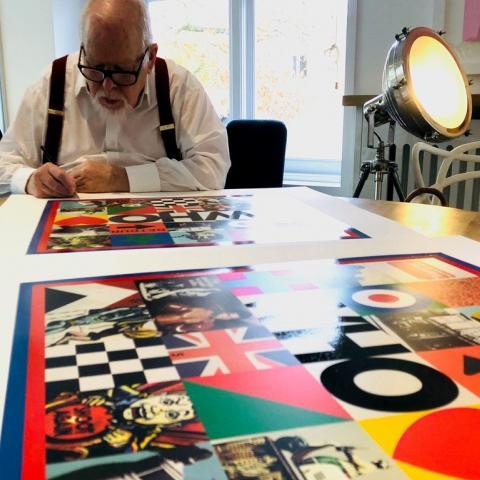Since 2007, Enter Gallery have enjoyed a wonderful relationship with Sir Peter Blake and are extremely proud to hold one of the world's largest collections of his printed editions.
In this blog, we’re taking you on a deep dive into the life and times of this national treasure to reveal exactly what makes him so significant to the face of contemporary art. We’ll look at how a working class lad from Dartford found himself in art school, and how his fascination with popular culture kickstarted the UK's Pop Art movement. We’ll also examine the different styles Blake has applied himself to over the years, from collage classics to top typography and painted portraiture.
If you’ve always wondered what earned Peter Blake his moniker, 'The Godfather of Pop Art’, then read on…

“I invented Pop Art, if one is being arrogant.” Peter Blake
The Origins of an Icon
Who would have thought that an electrician’s son from Kent would go on to become a leading figurehead of the Pop Art movement, as well as one of Britain’s most influential painters, printmakers, sculptors and designers.
Blake’s long and winding artistic career began over eight decades ago, when he walked through the doors of Gravesend Technical College Junior Art School at the age of 14. Speaking of this time, it seems his decision to pursue art was quite the split-second decision…
“I didn’t get into the very good local grammar school in Dartford, like my brother and sister. I tried for the technical school in Gravesend – my dad was an electrician, so I was thinking about the building trade – and the art school was part of it. Quite by chance I’d decided I wanted to be a painter, so they sent me round the corner to do a drawing. I was recommended that I wouldn’t make a living as a painter and should go into the graphic design school to do commercial art. So I did a year studying for a national diploma in graphic design, cycling there and back every day from Dartford to Gravesend.”
During his time in Gravesend, Blake was initiated into high culture via classical musical and fine art. He mastered skills such as life drawing and typography, that would go on to inform his entire career. And, perhaps most importantly, this is the period when teachers and guest lecturers sparked the fascination with folk arts, local legend and vintage ephemera that Blake would go on to capture in his art over and again.
Time to Paint
After leaving art school, Blake went on to study at the Royal College of Art, studying alongside a cohort comprised of era-defining artists including David Hockney, Bridget Riley, Frank Auerbach and Pauline Boty.
Blake had applied to the Royal College of Art as a graphic designer, but one painting in his portfolio, depicting his sister, Shirley, captured the eyes of his tutor, and Blake finally found himself studying the discipline that interested him most.
Not only did this portrait of Blake’s sister set him on the right path, but it was the first of many portraits Blake would paint that would go on to earn him his fame and fortune. More on his iconic portraits below.
Blake’s year at the RCA were a time of great inspiration. Tutors like Ruskin Spear, who was inspired by the Dadaists, was the first to encourage Blake to look to popular culture for his work. Speaking of that time, Blake reveals:
"It was from about 1954 I realised that I could paint the subjects I liked such as wrestlers and strippers and the rest of it."
After his studies, Blake received a scholarship which allowed him to travel the world for a year. While many of his counterparts took their opportunity to study ancient masterpieces and architecture, Blake instead embedded himself in the subcultures that interested him most, attending bullfights, football and wrestling matches, as well as travelling with the circus for a number of weeks.

This was clearly time well spent, as the inspirations Blake derived from his travels have become the motifs that define his entire career.
Pop Art Protagonist
We’ll forgive you for assuming, like the rest of the world, that Pop Art was created by Andy Warhol. The truth is that after Blake left college in 1956, his earliest works were some of the first to explore the idealism of American culture and the advertising of the time.

Blake created reproductions of Captain Webb matchboxes, recognising the aesthetic promise of consumer branding long before Campbell’s Soup was even a twinkle in Warhol’s eye. And for the record, Blake also made art based on flags before Jasper Johns, and comics long before Roy Lichtenstein. Just saying…
"That I did those things early, before the artists who got the credit for inventing them, it's important to me."

Alongside this fascination with Americana, Blake has always drawn inspiration from the world he was experiencing, from the performers that entertained him and the tools he used in the kitchen, to the paintings he admired and the literature he consumed.
Many of Blake’s paintings are inspired by, or reference, classic artworks, and his love of literature has cropped up in multiple pieces, whether that’s in colourful art prints from the 70s inspired by Through the Looking Glass, to one of his lifelong obsessions - his ambitious visual representation of Dylan Thomas’s infamous play, Under Milk Wood.
We believe Blake’s brand of Pop Art has captured the hearts of so many because every piece he makes is infused with a sense of the affection he feels for his specific fixations. It’s undeniable. Blake’s unique blend of modernity and nostalgia has played a huge part in shaping the culture of Great Britain.
“Right from the start, I painted the things I was interested in, from comics and music to film stars and fairground people, and that’s what led into pop art.”
Painting Perfection
Let’s now take a look at some of the disciplines for which Blake is best known, starting with painting - his one true love.
“I have this analogy of a tree. The branches are all my collages and collections, graphics, printmaking. But the trunk is the painting. It is important that I do things like record covers, but perhaps it is not as important as a big painting.”
It seems wonderfully fitting that it was a painting that first rose Blake to prominence. Self-Portrait with Badges (1961) was premiered at the annual Young Contemporaries show hosted by Royal Society of British Artists.
The piece (pictured below) depicts Blake dressed like a typical Mod, sporting badges from all his favourite bands. In the portrait, Blake declares his love for American culture via baseball boots, a stars and stripes patch, and a magazine about Elvis Presley.

Not only did this portrait win Blake the John Moores Painting Prize, but it also landed him a spot in a landmark art documentary by Ken Russell, Pop Goes the Easel. If people didn’t know about him before, this appearance certainly brought Blake and his art to the attention of the nation.
Nowadays, Blake is best known for fantastical paintings that meld old inspirations with those of the modern world. By teaming references to classical paintings with popular culture, Blake takes us into his imagination, introducing us to characters of his own creation, and helping us to see the profound beauty in everyday objects.
"You simply can't make art without having that history of art behind you and I think if you asked any artist they would always say they had learned from previous art. Perhaps I show that more than most in that I often appropriate art and quote from it."
Some of Blake’s most popular works are paintings, from his Lobster Suite, to his enormously-popular Tattooed People and Portraits and People series’ of watercolours.
“I’ve always had this great adoration of people who are different, and I have always celebrated them.”
It’s not just us who are impressed by Blake’s prowess with a paintbrush. In 2002, Blake’s contribution to painting was cemented when he became only the third British painter to be knighted.
Cutting-Edge Collage
Ask any prominent contemporary collage artists about their inspirations, and most will cite Peter Blake collage. From his many album cover artworks, to Sources of Pop and his Marcel Duchamp series, many of Blake’s most iconic artworks are a masterclass in how to cut and paste.
Diehard fans will know that Blake is an avid collector of vintage ephemera. His Chiswick Studio is apparently a sight to behold, packed to the rafters with over 50,000 items. Blake is apparently a magpie for everything from antique posters, flyers and magazines, to more unusual curiosities, such as taxidermy animals, puppets and toys. It’s from this extensive collection that many of Blake’s collages are born.
Blake is known for collages crafted from vintage imagery. His artworks celebrate popular cultural phenomenon and bring imaginary scenes to life, courtesy of collaged crowds populated by animals, celebrities and everything in between.
These so-called ‘Magic Crowds’ are perhaps the most defining feature of Blake’s collage art. Unexpected people side-by-side have become a staple, and are seen in many of his most recognisable works, from Marcel Duchamp, Superheroes and Vichy: The Butterfly Man, to his coveted BBC series.
While Blake himself isn’t exactly a fan of talking about it, we can’t speak about his career and his collage prowess without mentioning the album artwork for The Beatles’ album, Sgt Pepper’s Lonely Hearts Club Band – an early example of one of his ‘magic crowds’ and an artwork you’ll be able to experience for yourself at Enter Gallery on June 21st.
Briefly, Blake and his then wife, Jann Haworth, were brought in to create the band’s artwork, after art dealer, Robert Fraser, convinced Paul McCartney the cover should be a piece of fine art in itself.
Blake and Haworth’s idea was based around a flower clock, but soon evolved into a whole storyline, whereby the band had just finished a gig in a park, and a group of fans had grouped behind them for a photograph.
To create the album artwork, they blew up collaged figures to life-size proportions to create their magic crowd, then posed the band in front, surrounded by real flower arrangements. The people in the crowd were chosen by the Beatles but Blake and Haworth also managed to squeeze in a couple of their favourites too.

This collaboration may have only earned Blake £200, but as the Beatles’ most well-known cover, it catapulted Blake into superstardom, and led to many a collaboration with other bands who wanted a similar dose of artistic magic for their records.
Since then, Blake has designed record sleeves for The Who, Paul Weller, Oasis, and even made the artwork for Band Aid’s, Do They Know It’s Christmas Time.

Found Art
Peter Blake’s entire career has been inspired by the ethos of French artist, Marcel Duchamp, who famously declared in 1917 that, “anything is art if the artist says it is”.
Upon hearing this, Blake recalls feeling a sense of liberation, especially as he developed the passion for collecting that has gone on to define so many of his seminal works.
Blake is known for Found Art pieces that elevate discarded items into works of art. Whether it’s crumpled cigarette packets, old magazine advertisements or plastic figures, Blake regularly uses mundane and cast-away objects to create his work in line with one of the core tenets of Pop Art – the idea that everyday objects can become fine art.
While Andy Warhol many have been interested in advertising, Blake has always shown more interest in the things we throw away. Over the years, we’ve seen him create artworks from everything from cigarette packets to discarded ticket stubs.
Portfolios
Another theme seen across Blake’s oeuvre is his love of creating a portfolio, often producing multiple artworks based around a central premise.
Springing from his genuine passion for life and all that it offers, Blake’s portfolios bring together multiple artworks around one theme, diving into inspirations that range from landmarks in different cities, to stars of the stage and screen.
Amongst Blake’s long list of iconic portfolios are his London Suite, in which he brings his magic crowds to the street of our nation’s capital, weaving unusual narratives in front of hotspots like the Houses of Parliament and Horse Guards Parade.
Other highly-collectible portfolio works by Blake include his 3D Wooden Puzzle Series, his American Trilogy and his Homage to Rauschenberg series, which celebrated the artistic stylings of one of his biggest influences - American visual artist, Robert Rauschenberg.
Interestingly, the Homage to Rauschenberg series isn’t the only collection Blake has created to honour the work of another artist. Over the years, he has also created two portfolios in tribute to Damien Hirst (who Blake also regularly honours via a butterfly motif), and has even been inspired by himself!
In his beloved 2009 Replay series, Blake used his own early work to inspire a new pop art portfolio, characterised by the bright colours, bold patterns and simplistic compositions that have defined much of his oeuvre.
Typography
Finally, let’s turn to Blake’s typography art. Ever since his days at Gravesend Art School, Blake’s love of letters and the forms they make has permeated his artistic output, with many a collection created in celebration of the written word. Blake’s typographic works are considered an extension of the exploration of childhood innocence and nostalgia that permeate his entire oeuvre.
Over the years, we’ve seen Blake express his penchant for typography via multiple collections depicting alphabets.
A couple of the most collectible are his Dazzle Alphabet, his Appropriated Alphabets, and his 1991 Alphabet Series of letters depicting pop art inspirations from everything from A to Z.



















